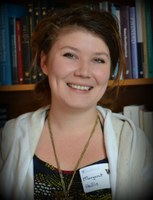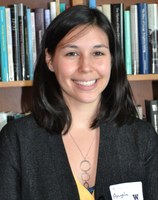Senior Thesis Division
|
|
Elizabeth Hasseler (History) In twelfth-century northern England, the historical imagination was dominated by the region’s most powerful and most popular saint. Both the bishops of Durham and the priors of the Benedictine convent attached to Durham cathedral drew on St. Cuthbert’s renowned history and well-established authority to underline their own spiritual legitimacy. Involvement with the saint’s cult was not limited to the ecclesiastical elite or the monks of the cathedral convent, however. Throughout the twelfth century, lay interest in the religious life dramatically increased, and saints’ cults were a popular focus of lay religious energy. Reginald of Durham’s Libellus de admirandis beati Cuthberti virtutibus, complied in the 1160s and 70s, provides a richly detailed glimpse of this period when the saint’s miracle working powers were claimed by religious and laity alike. Much scholarly attention has already been paid to the increasing prevalence of pilgrimage to Cuthbert’s shrine in the twelfth century. Pilgrims who visited Durham generally sought miraculous cures for illnesses or injuries, and as we would expect there is a higher proportion of stories about healing miracles in the Libellus than in earlier works of Cuthbertine hagiography. But pilgrims were not the only laity who became involved in St. Cuthbert’s cult in the twelfth century. In addition to stories of miraculous healing, Reginald’s Libellus contains accounts of the saint arbitrating the conflicts of lay inhabitants of the bishopric of Durham. My research examines these often overlooked “miracles of justice” in order to provide a fuller picture of lay interaction with St. Cuthbert in twelfth-century Durham. I analyze miracle stories involving freeing from false imprisonment; protection of lay interests; and punishment of immoral behavior in order to explore how and why members of every social strata increasingly claimed the patronage of the saint in order to mediate secular conflict. What emerges is a clearer portrait of a distinctive local political and social culture underlined by communal association with St. Cuthbert. Access: Project ©Reproduction of this award project in part or in whole without permission of the author is expressly prohibited. |
 |
Margaret Hellis (Comparative History of Ideas) How we see defines what we see: vision is organized by the conditions of our existence, by history and by context. For myself, my journeys in and through photography are in some ways liberated by this knowledge, in the sense that if I bring an awareness of this conditioning and relationality to my work I can aim to disrupt the ways the camera can extend privilege, power and objectification. This project is situated as an artistic intervention in practices of looking particularly while traveling, an intervention driven by the acknowledgement of these structures of power and regimes of seeing and the incorporation of such back into photographs taken while traveling. Building upon the intellectual work of Walter Benjamin, Roland Barthes, Jonathan Crary and Elizabeth Edwards, this paper examines the potentiality of photography as both technology and as artistic tool, as well as the implications of its uses in either regard. This paper is accompanied by an installation of images-not of ‘photographs’ but of ‘artworks,’ where the term ‘artwork’ is deployed to name these pieces’ explicitly conceptual rather than perceptual nature. Through the melding of images from Bangalore and from Seattle as the first part of the exhibition, and through the ‘opening up’ of images from Sierra Leone as the second part of the installation, this exhibit aims to provoke a remaking of memory and a foregrounding of photographer as author and organizer of vision. This installation encourages viewers to reconsider the uncomplicated consumption and digestion of visual cultural information. These images do not aim to erase or elide the unease of seeing and cataloging of difference, but rather in foregrounding these practices and the regimes of cultural knowledge that scaffold them, they gesture toward a more ethical attending to the politics of looking and the experience of subjectivity. Ultimately, this project aims to pry open greater possibilities for ethical action in this building of a space for visual dialogue. Access: Project ©Reproduction of this award project in part or in whole without permission of the author is expressly prohibited. |
 |
Claire Palay (History & Communication) My research examines the popular reactions to the 1973 PBS series An American Family, the first reality television show, as a lens to explore the prevailing attitudes of family and gender in 1973. The 1970s were a particularly tumultuous period in American politics and culture. Historical works on the period have focused primarily on the political conservatism which emerged in this decade. Thus, An American Family has most frequently been used to illustrate the pervasive fear of American decline viewed by many as the source of rising conservatism. I challenge this particular interpretation of the significance of An American Family. Rather than focusing, as the majority of historians have, on the negative reactions to the show, I argue that responses to the show’s main character, Pat Loud, were generally positive and reflected a growing acceptance of feminism and the possibility of alternative family structures. Access: Project ©Reproduction of this award project in part or in whole without permission of the author is expressly prohibited. |
Senior Non-Thesis Division
 |
Angela Corwin (French) A written history of the Grand Army of the Republic Cemetery located in Seattle, WA and an inquiry of the significance of the cemetery in modern times. Access: Project ©Reproduction of this award project in part or in whole without permission of the author is expressly prohibited. |
 |
Lisa Lester (Spanish & International Studies) With the rise of Islamist parties to power in Egypt, the question of how women will be affected by the Islamist agenda has gained new urgency. This research examines the rise of Islamic health services as well as the Islamist movement in Egypt in order to assess how women are affected by these phenomena. Governmental Egyptian health services have declined in both quality and quantity since the establishment of the Nasserist welfare state during the 1960s. Services affecting women, in particular, have varied in coincidence with the state’s pattern of repression, supervision and cooption of healthcare organizations in the Parallel Islamic Sector. Islamic hospitals and clinics, some affiliated with Islamist political organizations such as the Muslim Brotherhood, have grown in popularity and influence during the past several decades. Research indicates that Islamic and Islamist health clinics consistently out-perform the state in the provision of health services to many Egyptians, and generally provide high quality, modern and Western medical care. Analyzing the popularity of these parallel Islamic organizations will illuminate how these services substituted for and subsequently challenged the legitimacy of the state in providing healthcare to Egyptian women. Access: Project ©Reproduction of this award project in part or in whole without permission of the author is expressly prohibited. |
 |
Paulina Przystupa (Anthropology & History) The nationalist movement in Egypt of the late 19th century and early 20th century introduced ancient history into everyday discourse through public displays of monumental sculpture and art. These works brought Pharaonic themes into contact with another major issue of the time, the “woman question” or early Egyptian feminism. The juxtaposition of Pharaonic themes and women, especially in the art of Mahmoud Mohktar and Muhammad Nagi, accented the ways in which new Egyptian art could combine feminist discourse with nationalist rhetoric relating to Ancient Egypt. By historicizing the Pharaonic and gendered art of Mahmoud Mokhtar and Muhammad Nagi I will show that these new Egyptian artists used their work to explore progressive portrayals of women. I do this by answering two important questions, namely how did this “first generation of Egyptian artists” depict women and how did their art intersect with the feminist movement. Access: Project ©Reproduction of this award project in part or in whole without permission of the author is expressly prohibited. |
Non-senior Division
 |
Alexandria Ferguson (International Studies) In this paper I conduct a discourse analysis of the Development paradigm to understand how aid workers control the production of knowledge around women of the Global South. In exploring how the development apparatus depicts women, I analyze the representations of women in real marketing materials from the Seattle-based NGO, The Bill and Melinda Gates Foundation. This paper draws on critical development theory and post-colonial feminism to deconstruct how the discourse of the Gates Foundation functions as an important factor defining the relationship between the Global South and the Global North. I argue that the Gates Foundation constructs reductive images of women through their roles as mother and farmers, without specificity, credible evidence or historical context, thereby reducing the agency and the complexity of the everyday lives of women from the Global South. These simplistic interpretations have real effects by informing the policy of development workers on the ground Access: Project ©Reproduction of this award project in part or in whole without permission of the author is expressly prohibited. |
|
|
Margaret Lundberg (IAS – Self & Society) My intent is to explore three Bollywood films and the depictions of Indian life that they offer, especially as they relate to attitudes toward women and girls. The ideals held up within each film will be discussed side by side with the images that each presents, then compared and contrasted with the current realities of life for these women and their daughters-looking especially at those involving the abilities of women to choose their husbands, the high cost of weddings and/or dowries, and the all-too-frequent violence inflicted on women and girls in India in the way of dowry-related cruelty, torture and sometimes death. Access: Project ©Reproduction of this award project in part or in whole without permission of the author is expressly prohibited. |
Honorable Mentions
Vincenzina Robertson (History)
Faculty Advisor: Mary Hanneman, Interdisciplinary Arts and Sciences, UW Tacoma
Senior Thesis: Soaring Eagles of the High Qing: Women’s Writing as a Path to Social Advancement in Patriarchal China
Christine Woodward (Geography & Latin American Studies)
Faculty Advisor: Jose Antonio Lucero, Jackson School of International Studies
Senior Thesis: Viva a Revolução/Sent from my iPhone: Politics, culture, and the Fora PM movement
Hannah Giese (History)
Faculty Advisor: Charity Urbanski, History
Non-Senior Project: Death and the Dancing Fairy: Silkie and Vila Folktales as Violations of the Christian Patriarchy
Kyra Lindstrom (Community Psychology)
Faculty Advisor: Kristine Kellejian, Interdisciplinary Arts and Sciences, UW Bothell
Non-Senior Project: The Lifetime of Shyness: Case Studies on Shyness

